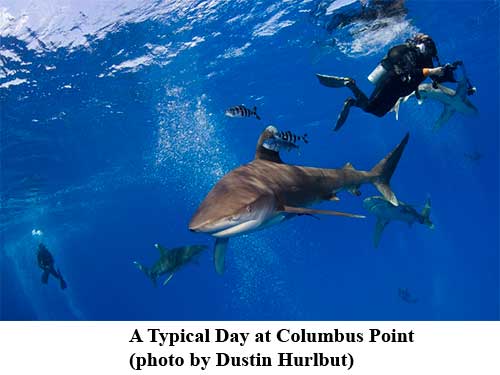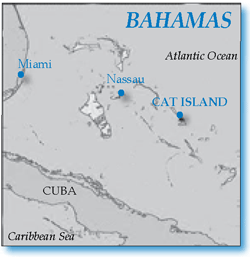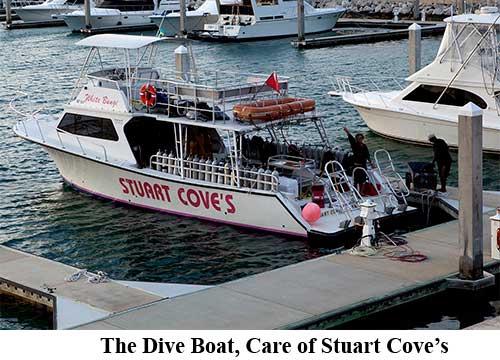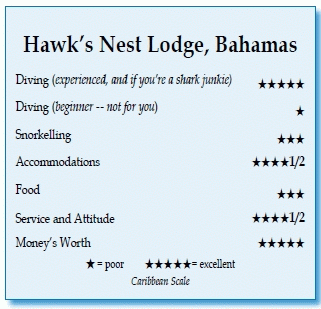Hawk’s Nest Lodge, Cat Island, The BahamasContents of this Issue: Hawk’s Nest Lodge, Cat Island, The Bahamas Fiji Airways: A Major Link in the Shark Fin Trade What to Tip on Your Next Dive Trip: Part II “Now I Can Pig Out on Trips with Less Guilt” Why Some Indonesia Liveaboards Don’t Take Credit Cards Will Honduras End Scuba Diving for Lobster? Are You Getting Free Gear to Review? Whale Sharks Are Getting Too Much Love Editorial Office: Ben Davison Publisher and Editor Undercurrent 3020 Bridgeway, Suite 102 Sausalito, CA 94965 hanging in the blue with oceanic whitetips from the June, 2013 issue of Undercurrent
Dear Fellow Diver: Even after years of waiting for this moment, and countless worldwide encounters with sharks (including some bad-ass ones), I wasn't wholly prepared for the first experience. An eight-foot oceanic whitetip shark, cruising perhaps 70 feet away, made a seamless left turn and headed directly for me. From my perspective, her massive pectorals and dorsal formed a near-perfect equilateral triangle; the resemblance to the business end of a World War II fighter was overwhelming. The featureless sapphire blue of our surroundings did nothing to reduce the effect. At the last second, she made an invisible course correction and passed within a foot of me. After a few seconds, my heart rate and breathing returned to normal ,and my brain re-engaged. Its first thought: "Oh my God, let's do that again."
On my first day, I boarded the dive boat, chartered from Bahamian dive lord Stuart Cove, at the Hawk's Nest Marina, on the south end of Cat Island (which is shaped and oriented uncannily like Italy). The boat is 46 feet long and designed to hold up to 30 divers. It has plenty of shade cover and a perfectly adequate marine head. I wouldn't want to be on a 20-person charter on it, but for our group of a dozen diver/photographers, it was perfect. The crew, all Stuart Cove employees, came with the boat. They set up our gear for us, and then we left it on the boat for the week. We were responsible for washing it when the trip was over. The crew struck the perfect balance between doing for us and allowing us to handle things as we wished. There were no newbies on the trip, and we all had our idiosyncrasies.
This is where human stupidity comes in. According to the Wikipedia page about oceanic whitetips, they suffered a population reduction of 70 percent from 1992 to 2000 in the area we were diving, thanks to long-lining and finning. So we waited. Nobody suggested we head the half-mile inshore to dive a reef. There wasn't even much whining. After a couple of hours without any success, the crew went to Plan B, which was to troll a baitfish and try to hook a tuna or mahimahi. The idea was that the fish struggling on a line would ring the dinner bell for the whitetips. Somewhat to my surprise, we managed to hook and play five mahi-mahi. Even more to my surprise, not a single shark arrived to take advantage of the captive fish. At 3 p.m., with nary a shark sighting (but some fresh mahi in the cooler), we headed back to the resort with dry wetsuits. If we couldn't dive with sharks, we weren't diving. If you're going to get skunked on a day of diving, Hawk's Nest Lodge is a perfectly fine place to drown your sorrows in a $6 Kalik beer. All 10 rooms are clean, well maintained and have a view to the ocean. It's a 50-yard walk to the hammocks and a gazebo at the beach, a perfect place to read a book. Hawk's Nest is located away from everything, so it's not like you can walk into "town" for a beer or a meal. I could get a cab to somewhere, but what little there is on the island takes a 30-minute cab ride. The lodge has a dive shop at its marina, but I was self-contained with Stuart Cove so I didn't investigate it. The A/C in the rooms works well, as does the plumbing. What else would you want? Well, I'd want Wi-Fi in the rooms. The only Wi-Fi access point is in the office, which is in a small separate building (there's an old Dell desktop for public use). I got the best signal either by sitting in the office (they were happy to have me there if they were open) or in the chairs out front. The problem was that I was exposed either to the sun or, in the evenings, a blitzkrieg of sand flies that left me looking like a chicken pox patient the first night. The lounge/dining-room combination was a tolerable compromise of safety from insects and a marginally adequate Wi-Fi signal. The lodge itself is a large, airy room divided into a bar/TV area and a dining room. It looks like every other perfectly reasonable diving/fishing lodge I've ever visited in the tropics. There's a big-screen TV that was turned on way too much (the NBA playoffs were on, to be fair). Out the back is a patio and freshwater swimming pool, which give way to a short boardwalk down to the beach. All in all, a lovely place to spend downtime. Were I stuck there, I'd have been fine for two to three days until cabin fever set in.
Dinners were unfortunately hit and miss; they just brought us whatever was on our menu that day. It was always edible and sometimes good but never stellar. I realize that the resort is in the back end of never, so supplies are difficult to get and expensive. But a little creativity would have gone a long way. In particular, I felt bad for Andy, a vegetarian. The kitchen staff seemed clueless about how to feed him, except for they knew not to put a pork chop on his plate. Too often, his meal seemed to be our "meat/vegetable/starch" offering, less the meat. If you are a vegetarian, consider bringing some bags of beans and showing the kitchen staff how to prepare them. Over a post-dinner Kalik in the lounge on the first night, I got to talking with a group of sport fishermen who were also staying there. They complained bitterly about losing hooked fish to sharks, even seeing the sharks snatch the fish just as they were about to boat them. Needless to say, my ears perked up, and I asked, "Where was this?" So on day two, we headed to Columbus Point and started the chum/slick exercise again. It wasn't 15 minutes before the first whitetip showed up, cruising around the back of the boat to slurp up the fish bits Charlotte was tossing in. There was also a bait box suspended at 30 feet, which kept the sharks interested once they found us. When I got in the water, Beto was hanging near the bait box. He held up two fingers, then pointed to a second shark. I drifted down and just marinated in the blue infinity with two exquisite apex predators swimming around us. Before the other divers get into the water, I should take a minute to talk about why you might choose to spend a week of your life (in my case, four days of two tanks each) just to be close to this one particular species. Suppose somebody said to you, "You can sit in among a herd of elephants or a streak of tigers (yes, that's the official term) for three hours each day for a week. If you were an elephant or tiger junkie, you'd probably drop everything to sign up. Oceanic whitetips date from the Jurassic period; they're perfect for what they do, and you know it the minute you get close to one. Their grace, cool and situational awareness is astonishing. And when you see sunlight dappling their back as they cruise at the surface, you wonder if any creature can be more perfectly designed, more beautiful.
The only time the predator/prey balance shifted a bit was at the end of the dive. Without exception, once a diver surfaced and began swimming toward the boat, a couple of sharks would peel out of the diver/shark constellation and go see what the commotion was on the surface. For these open-ocean predators, commotion on the surface often means food (yes, they are the ones who have picked off countless shipwreck victims over the centuries). They'd pull right up behind me or shadow me directly below. If one got too close, a kick with a fin would always send it away for a minute. I began to think of it as a game called "Where's the Escort?" It wasn't a question of whether you had one; it was simply a matter of finding her. Every day afterward, we went to Columbus Point and never had fewer than five sharks on each of the two dives. Eight was more common, and I laughed the first time Beto had to flash 10 fingers and then two more to show we were surrounded by a full dozen oceanic whitetips. During multiple dives, schools of rainbow runners would pass through or below us; whether they were attracted to the bait slick or just coincidentally in the area, I don't know. Then on one magic dive, a blue marlin came screaming into such a school, twisting left and right as he tried to snare one of the rainbow runners. All that action was a bit deeper than I wanted to chase, but I got a good view of the proceedings from above. A couple of divers plummeted down into the maelstrom and got good marlin shots. There were also brief sightings of a single sandbar and a single silky shark -- I saw neither. If you want to be sure of seeing silkies, there are better places to go. While the trips are not photo seminars, and there's no formal instruction, Andy is a top-notch pro "shooter" and was always willing to share expertise or review shots for people. The group was full of serious amateur photographers, and we spent much of the down time on the boat discussing the minutiae of underwater photography. My group was mostly Americans, with a delightful quartet of Italian divers to add some garlic and oregano to the sauce. There were more than a few of us with gray hair -- you need to have found a deep passion in life to go on this trip. Most importantly, there wasn't a bozo diver in the bunch. There was the usual mix of personalities (some more enjoyable than others), but to a diver, they were supremely competent both in and out of the water. If you're fresh out of certification camp, pass on this trip until you have at least 100 dives. It is very much every man (or woman - there were three in my group) for himself or herself. The divemaster is there to help, but with a cloud of a dozen diver/photographers around him (or her), you're mostly on your own if you have a gear problem. Furthermore, photographers are the epitome of solo divers -- they have no awareness of anything around them except whatever they're trying to shoot. An example: A photographer's tank slipped out of his BC and was happily floating there, held only by his regulator hoses. He didn't even notice until one of the two non-photographers in the bunch came over and reattached the tank (the divemaster had spotted the issue and was headed there too). This is also not the trip for those who have buoyancy control issues. You are suspended, untethered and over a 1,000 feet of water, so if you drop it, it's gone). If you spend the entire dive trying to get your buoyancy right, at the least you won't enjoy the dive much, at the worst, you'll be in severe danger. And this diving is hard on your ears. The bait box is at 30 feet, and there's rarely a need to go below it. On the other hand, the sharks are often at the surface, so that's where you go to see them. This means a long dive (often 90 minutes or more) where you're constantly moving between zero and 30 feet -- pretty much the agony zone for most people's ears. I have tolerant Eustachian tubes, but my ears were gurgling for a week after the trip. On the last day of diving, we tried a behavioral experiment. Hoping to attract more in-shore species, the boat began "towing" the sharks by driving slowly shoreward while keeping a constant supply of fish bits going into the water. We weren't sure if the whitetips would leave the comfort of the deep, but they followed us like puppy dogs, enabling the photographers to get some unusual (and perhaps incongruous) images of oceanic whitetips over reef bottom. Sadly, no reef sharks arrived to join the fun, but I lost count at 13 oceanic whitetips swimming around over the reef while photographers burned through terabytes of SD cards. It was a perfect finale to an awesome trip. -- D.M.
|

I want to get all the stories! Tell me how I can become an Undercurrent Online Member and get online access to all the articles of Undercurrent as well as thousands of first hand reports on dive operations world-wide
| Home | Online Members Area | My Account |
Login
|
Join
|
| Travel Index |
Dive Resort & Liveaboard Reviews
|
Featured Reports
|
Recent
Issues
|
Back Issues
|
|
Dive Gear
Index
|
Health/Safety Index
|
Environment & Misc.
Index
|
Seasonal Planner
|
Blogs
|
Free Articles
|
Book Picks
|
News
|
|
Special Offers
|
RSS
|
FAQ
|
About Us
|
Contact Us
|
Links
|
3020 Bridgeway, Ste 102, Sausalito, Ca 94965
All rights reserved.

 The shark and I were just 25 feet deep off Cat Island
in the Bahamas. It's one of the better places to find
these critters, though they exist in the deep waters of
tropical oceans around the world. I was one of 11 divers
on an oceanic whitetip photography trip with Big
Fish Expeditions, the operating brand for underwater photographer
and
tour leader Andy
Murch, who works
out of Victoria,
Canada. Andy,
a 40-something,
big-animal-hugging
adventure junkie
is easygoing and
good company. He
also has a story
or two (ask him
about being held
at gunpoint).
True to his
branding, Andy takes divers to see and photograph big animals, with
a particular emphasis on sharks. In fact, two of
my fellow divers had just come from Tiger Beach,
another Bahamian venue where they'd spent a week
with Andy shooting lemon and tiger sharks. Which
gets me to an important point: If you want to see
pretty reefs and the usual tropical reef fish,
this is not your cup of tea. The divers were
there for one reason -- to get close to as many
oceanic whitetips as possible, and get as many
high-quality photos as they could. And sometimes
that means suffering at the hands of fate and,
well, human stupidity.
The shark and I were just 25 feet deep off Cat Island
in the Bahamas. It's one of the better places to find
these critters, though they exist in the deep waters of
tropical oceans around the world. I was one of 11 divers
on an oceanic whitetip photography trip with Big
Fish Expeditions, the operating brand for underwater photographer
and
tour leader Andy
Murch, who works
out of Victoria,
Canada. Andy,
a 40-something,
big-animal-hugging
adventure junkie
is easygoing and
good company. He
also has a story
or two (ask him
about being held
at gunpoint).
True to his
branding, Andy takes divers to see and photograph big animals, with
a particular emphasis on sharks. In fact, two of
my fellow divers had just come from Tiger Beach,
another Bahamian venue where they'd spent a week
with Andy shooting lemon and tiger sharks. Which
gets me to an important point: If you want to see
pretty reefs and the usual tropical reef fish,
this is not your cup of tea. The divers were
there for one reason -- to get close to as many
oceanic whitetips as possible, and get as many
high-quality photos as they could. And sometimes
that means suffering at the hands of fate and,
well, human stupidity. We took a 30-minute ride to an area where a group on a different tour had
encountered three sharks the day before. Parked over a practically bottomless
ocean, divemasters Charlotte and Beto prepared and deployed an unholy stew of
chopped fish and menhaden oil. Within a few minutes, a clearly visible slick
extended to the limits of our vision. Surely we'd see white-tipped rounded dorsals
cutting through the water at any moment.
We took a 30-minute ride to an area where a group on a different tour had
encountered three sharks the day before. Parked over a practically bottomless
ocean, divemasters Charlotte and Beto prepared and deployed an unholy stew of
chopped fish and menhaden oil. Within a few minutes, a clearly visible slick
extended to the limits of our vision. Surely we'd see white-tipped rounded dorsals
cutting through the water at any moment. My package included all meals, and if I wasn't satisfied with what they
were serving on a particular evening, I could get food a la carte (out of my
own pocket, of course). Breakfast was borderline sumptuous, including eggs,
bacon, pancakes (on some days), fresh fruit and toast, all served buffet
style. They packed sandwiches and fruit for us to take on the boat (the last
question I heard before the boat left the dock each morning was, "Do we have
the lunches?").
My package included all meals, and if I wasn't satisfied with what they
were serving on a particular evening, I could get food a la carte (out of my
own pocket, of course). Breakfast was borderline sumptuous, including eggs,
bacon, pancakes (on some days), fresh fruit and toast, all served buffet
style. They packed sandwiches and fruit for us to take on the boat (the last
question I heard before the boat left the dock each morning was, "Do we have
the lunches?"). More divers entered the water, and more
sharks appeared, as if to offer good shooting opportunities for all the photographers.
Over the course of that
dive, Beto eventually got up to five
fingers -- all five animals were adult
females ranging from six feet up to
probably nine feet (one massive specimen
I referred to as "Submarine"). The
sharks were curious. I would describe it
as a wary respect, along the lines of,
"I don't know what you are, you don't
give off 'wounded' vibes, you're about
my size, and we didn't make it 150 million
years as a species by randomly
attacking things we didn't recognize."
But they would pass very close to us,
and clearly had a sense of which direction
we were looking. I would routinely
see a look (or a lens) from another
diver, then turn around and see nothing
but gray-green shark body passing in my
field of vision.
More divers entered the water, and more
sharks appeared, as if to offer good shooting opportunities for all the photographers.
Over the course of that
dive, Beto eventually got up to five
fingers -- all five animals were adult
females ranging from six feet up to
probably nine feet (one massive specimen
I referred to as "Submarine"). The
sharks were curious. I would describe it
as a wary respect, along the lines of,
"I don't know what you are, you don't
give off 'wounded' vibes, you're about
my size, and we didn't make it 150 million
years as a species by randomly
attacking things we didn't recognize."
But they would pass very close to us,
and clearly had a sense of which direction
we were looking. I would routinely
see a look (or a lens) from another
diver, then turn around and see nothing
but gray-green shark body passing in my
field of vision. Divers Compass: My trip cost $2,195, plus I upgraded to a single
room for another $200 for the week . . . Fly to Nassau
and then to Cat Island on Sky Bahamas, and it's a 45-minute
taxi ride ($15 per person) to the Hawk's Nest; if you've got
your own plane (who doesn't?), Hawk's Nest has its own runway
100 yards from the office door (the chatter among the fishermen
often flowed smoothly between how the mahi were hitting and the cost of aviation fuel) . . . . Beer is $6, sodas are $3, and spirits are
available on an honor-based system -- you write down what you're taking out of
the cooler. . . Water temperature was in the mid-70s in late April, so don't
let the bikini-clad models in the magazines fool you -- wear a 5mm wetsuit
head to toe, and a hood of some sort; you're going to be underwater for about
three hours each day . . . Despite eating whatever I wanted during the week,
including the home-baked goodies they parked at the bar each evening, I lost
four pounds on the trip. . . Bring gloves -- Andy says that white hands waving
around underwater look suspiciously like bits of fish; I dove bare-handed
and never had a problem, but I'll take (black) gloves on the next trip . .
. Website: Big Fish Expeditions -
Divers Compass: My trip cost $2,195, plus I upgraded to a single
room for another $200 for the week . . . Fly to Nassau
and then to Cat Island on Sky Bahamas, and it's a 45-minute
taxi ride ($15 per person) to the Hawk's Nest; if you've got
your own plane (who doesn't?), Hawk's Nest has its own runway
100 yards from the office door (the chatter among the fishermen
often flowed smoothly between how the mahi were hitting and the cost of aviation fuel) . . . . Beer is $6, sodas are $3, and spirits are
available on an honor-based system -- you write down what you're taking out of
the cooler. . . Water temperature was in the mid-70s in late April, so don't
let the bikini-clad models in the magazines fool you -- wear a 5mm wetsuit
head to toe, and a hood of some sort; you're going to be underwater for about
three hours each day . . . Despite eating whatever I wanted during the week,
including the home-baked goodies they parked at the bar each evening, I lost
four pounds on the trip. . . Bring gloves -- Andy says that white hands waving
around underwater look suspiciously like bits of fish; I dove bare-handed
and never had a problem, but I'll take (black) gloves on the next trip . .
. Website: Big Fish Expeditions - 